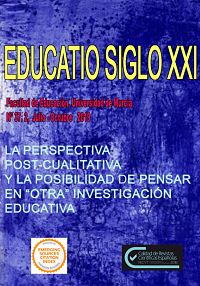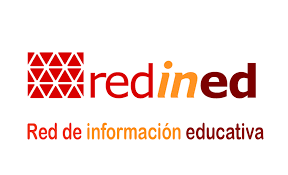Intra-actions in the learning of infant, primary and secondary teachers
Abstract
This article aimed to approach some forms, modes, moments and places of learning of infant, primary and secondary teachers from the perspective of new materialism and empiricism. We did this, not only by focusing on interactions with their contexts, but also from the notion of "intra-actions" since our purpose was to go beyond the metaphysics of individualism which underlies conventional interpretations of "interactions". This allowed us to overcome the separation that logical-positivist research tends to make between people and objects. This article, therefore, considered that in teacher learning contexts teachers and objects are interconnected before the researcher's gaze separated them. The learning cartographies and narrations provided by the teachers who participated in the research and the conversations held with them allowed us to identify in their learning processes the intra-actions of spaces, times, conditions, expectations, resources, artefacts, etc. This enabled us to glimpse the mutual constitution of entangled organisms and the blurred boundaries between bodies and objects, considering them as discursive material phenomena. From a post-qualitative perspective, we situated this analysis from what the theory allowed us to think so that, rather than 'obtaining results', we contributed to understanding teacher learning and its implications for practice and initial and ongoing training. The article ended by posing implications and challenges regarding the usual understanding of both learning and pre-service and in-service teachers’ professional development.
Downloads
-
Abstract1244
-
PDF (Español (España))891
References
Banks, J. A., Au, K. H., Ball, A. F., Bell, P., Gordon, E. W., Gutiérrez, K. y Zhou, M. (2007). Learning in and out of school in diverse environments. life-long, life-wide, life-deep. The LIFE Center for Multicultural Education. Recuperado de https://www.google.com/search?q=Learning+in+and+out+of+school+in+diverse+environments.+life-long%2C+life-wide%2C+life-deep&ie=utf-8&oe=utf-8&client=firefox-
Banks, M. (2001). Visual Methods in Social Research. London: SAGE Publications.
Barad, K. (1996). Meeting the Universe Halfway: Realism and Social Constructivism without Contradiction. En L. H. Nelson y J. Nelson (Eds.), Feminism, science, and the philosophy of science (pp. 161–194). Dordrecht: Springer.
Barad, K. (2003). Posthumanist Performativity: Toward an Understanding of How Matter Comes to Matter. Signs: Journal of Women in Culture and Society, 28(3), 801-831.
Barad, K. (2007). Meeting the universe halfway: Quantum physics and the entanglement of matter and meaning. Durham, NC: Duke University Press.
Barker, R. G. (1968). Ecological Psychology: Concepts and methods for studying the environment of human behavior. Palo Alto, CA.: Stanford University Press.
Berliner, D. C. (2002). Comment: Educational Research:The Hardest Science of All. Educational Researcher, 31(8), 18–20. doi:10.3102/0013189x031008018
Biesta, G. (2016). Democracia, ciudadanía y educación: de la socialización a la subjetivación. Foro de Educación, 14(20), 21-34. doi: http://dx.doi.org/10.14516/fde.2016.014.020.003
Clough, P. T. (2009). The new empiricism: Affect and sociological method. European Journal of Social Theory, 12, 43-61. doi:10.1177/1368431008099643
Coleman, R., y Ringrose, J. (Eds.) (2014). Deleuze and Reseach Metodologies. Edinburgh: Edinburgh University Press.
Coole, D., y Frost, S. (2010). Introducing the new materialism. En D. Coole y S. Frost (Eds.), New materialisms: Ontology, agency, and politics (pp. 1-43). Durham, NC: Duke University Press.
Dawani, S. y Loots, G. (2015). Doing research together: creating
spaces of collaboration with young people using visual methods. Visual
Methodologies. A postdisciplinary journal,
(1), 1 -17. doi: https://doi.org/10.7331/vm.v3i1.44
Deleuze, G., y Guattari, F. (2004). Mil mesetas . Capitalismo y esquizofrenia. Valencia: Pre-Textos.
Dolphijn, R., y Van der Tuin, I. (2012). New materialisms: Interviews and cartographies. Ann Arbor, MI: Open Humanities Press.
Foucault, M. (1988). El sujeto y el poder. Revista Mexicana de Sociología, 50(3), 3-20.
Foucault, M. (1991). El juego de Michel Foucault. En M. Foucault, Saber y verdad (pp. 127-162). Madrid: Ediciones La Piqueta.
Gell-Mann, M. (1994). El Quark y el Jaguar. Aventuras en lo simple y lo complejo. Barcelona: Tusquets.
Gutiérrez, K. D., y Penuel, W. R. (2014). Relevance to Practice as a Criterion for Rigor. Educational Researcher, 43(1), 19-23. doi:10.3102/0013189x13520289
Hernández, F. (2008). La investigación basada en las artes. Propuestas para repensar la investigación en educación. Educatio Siglo XXI, 226, 85-118.
Jackson, A.Y., y Mazzei, L. A. (2012). Thinking with theory in Qualitative Research. London: Routledge.
Kerr, S. (2014/11/14). Three Minute Theory: What is Intra-Action?[Archivo de video] Recuperado de https://www.youtube.com/watch?v=v0SnstJoEec
Latour, B. (1996). On actor-network theory. A few clarifications plus more than a few complications. Soziale Welt, 40, 369-381. Recuperado de http://www.bruno-latour.fr/sites/default/files/P- 67%20ACTOR-NETWORK.pdf
Law, J. (2004). After Method: Mess in Social Science Research. London y New York: Routledge.
Mason, J. (2002). Qualitative interviewing: asking, listening and interpreting. En T. May (Ed.), Qualitative research in action (pp. 225-242). London: Sage.
Maturana, H., y Varela, F. (1980). Autopoiesis and cognition: The realization of the living. Dordrecht, Holland: D. Reidel Publishing Company.
Mlodinow, L. (2013). Subliminal. Cómo tu inconsciente gobierna tu comportamiento. Barcelona: Crítica.
Morin, E. (1982). Science avec conscience. Paris: Fayard.
Morin, E. (2001). Introducción al Pensamiento Complejo. Barcelona: Gedisa.
Phillips, D. C. (2014). Research in the Hard Sciences, and in Very Hard “Softer” Domains. Educational Researcher, 43(1), 9-11. DOI: 10.3102/0013189X13520293
Prigogine, I., y Nicolis, G. (1997). La estructura de lo complejo. Madrid: Alianza.
Prigogine, I., y Stengers, I. (1984). Order out of Chaos: Man's new dialogue with nature. Toronto. New York, N.Y.: Bantam Books.
Rudolph, J. L. (2014). Why Understanding Science Matters: The IES Research Guidelines as a Case in Point. Educational Researcher, 43(1), 15-18. doi:10.3102/0013189x13520292
Sancho, J. M. (1995). Looking for the 'Right' Answers or Raising the 'Right' Questions? A Dialogical Approach to Automating Instructional Design. En R. D. Tennysony A. E. Barron (Ed.), Automating Instructional Design: Computer-Based Development and Delivery Tools (pp. 79-99). Springer-Verlag. NATO ASI Series F: Computer and Systems Sciences, Vol. 140.
Sclater, D. (2003). The arts and narrative research. Qualitative Inquiry, 9(4), 621-625.
Searle, J. R. (1992). The Ridescovery of the Mind. Cambridge, MA.: The MIT Press.
Southerland, S.A., Gadsden, V. L., y Herrington, C. D. (2014). Editors’ Introduction: What Should Count as Quality Education Research? Continuing the Discussion. Educational Researcher, 43(1), 7-8. doi:10.3102/0013189x13519962
St. Pierre, E. A. (2017). Haecceity: Laying Out a Plane for Post Qualitative Inquiry. Qualitative Inquiry, 23(9), 86– 698. doi: 10.1177/1077800417727764
St. Pierre, E. A., Jackson, A. Y. y Mazzei, L. A. (2016). New Empiricisms and New Materialisms. Conditions for New Inquiry. Cultural Studies ↔ Critical Methodologies, 16(2) 99–110.
Von Bertalanffy, L. (1968). General system theory; foundations, development, applications. New York: G. Braziller.
Wieman, C. E. (2014). The Similarities between Research in Education and Research in the Hard Sciences. Educational Researcher, 43(1), 12-14. doi:10.3102/0013189x13520294
Original work publishes in this journal is subject to the following terms:
1. Murcia University Press (the publishing house) holds the copyright of the publishes work, and favours and allows their reutilization under the use license stated in point 2.
© Servicio de Publicaciones, Universidad de Murcia, 2015
2. Work is published in the electronic edition under a license (Creative Commons Reconocimiento-NoComercial-SinObraDerivada 4.0 España (legal text). They can be copied, used, disseminated, transmitted and publicly presented, as long as: i) authorship and original publication source is acknowledged (journal, publishing house and URL of the work); ii) are not used for commercial purposes; iii) the existence and specifications of this use license is stated.
3. Conditions for self-archive. Authors are allowed and encouraged to disseminate electronically the pre-pint (before review) and/or post-print (accepted for publication) versions of their work before their publication since that favours earlier circulation and dissemination resulting in an increased chance for the authors to be cited and for the work to reach a bigger share of the academic community. Colour: RoMEO: green.








